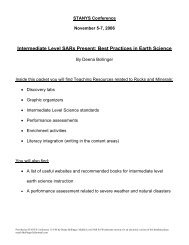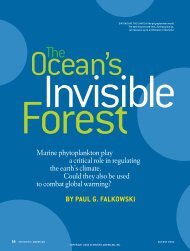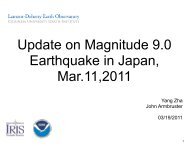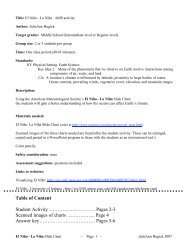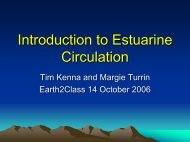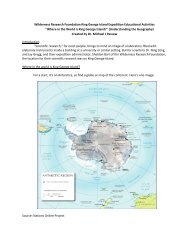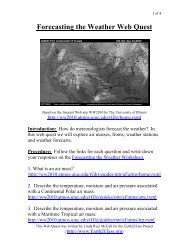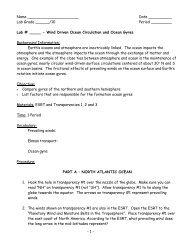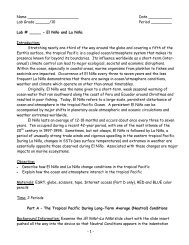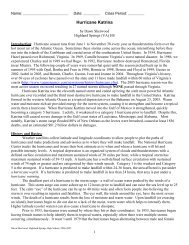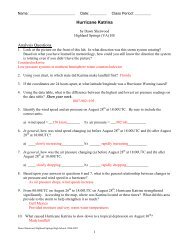The Effects of Upwelling and Downwelling
The Effects of Upwelling and Downwelling
The Effects of Upwelling and Downwelling
You also want an ePaper? Increase the reach of your titles
YUMPU automatically turns print PDFs into web optimized ePapers that Google loves.
Name ______________________<br />
Lab Grade ______/10<br />
Date __________<br />
Period _________<br />
Lab # _____ - <strong>The</strong> <strong>Effects</strong> <strong>of</strong> <strong>Upwelling</strong> <strong>and</strong> <strong>Downwelling</strong><br />
Pre-lab:<br />
1. Construct the “Model Ocean Basin”, Page 7<br />
a. Cut along the dotted lines<br />
b. Cut out the “Cut Out” parts <strong>of</strong> the model ocean basin<br />
c. In the circle<br />
i. W Arrows = Warm water, Color in RED<br />
ii. C Arrows = Cold water, Color in BLUE<br />
d. Use a pencil point to carefully, poke a small hole through the circle with the<br />
cross<br />
e. Place the model ocean basin over the circle, line up the two holes you made<br />
f. Attach the two papers with a paper fastener<br />
2. Read the background information<br />
3. Label the diagrams below as upwelling or downwelling<br />
4. Bring the lab <strong>and</strong> model to class<br />
Background Information:<br />
In some near-shore areas <strong>of</strong> the ocean, coastal orientation, prevailing winds, prevailing<br />
winds <strong>and</strong> Earth’s rotation combine to influence vertical ocean circulation. In these regions,<br />
the wind sometimes transports water in the upper 10 to 100 m (33 ft to 330 ft). This<br />
process, called coastal upwelling, brings to the sunlit surface nutrient-rich water, spurring<br />
biological productivity. At other times <strong>and</strong> places, the wind transports near-surface water<br />
towards the coast, causing warm surface waters to pile up <strong>and</strong> sink. This process, called<br />
coastal downwelling, thickens the layer <strong>of</strong> nutrient-deficient water, reducing productivity.<br />
<strong>Upwelling</strong> <strong>and</strong> downwelling are also associated with broad-scale atmosphere-ocean<br />
interactions (e.g. El Nino <strong>and</strong> La Nina) that can impact year-to-year variability in climate.<br />
Diagram:<br />
- 1 -
Objective:<br />
☺ Explain the causes <strong>of</strong> upwelling <strong>and</strong> downwelling<br />
☺ Describe the influence <strong>of</strong> the prevailing wind <strong>and</strong> Coriolis effect on upwelling <strong>and</strong><br />
downwelling<br />
☺ Explain how scientists use “ocean color” to monitor ocean productivity<br />
☺ Describe how upwelling <strong>and</strong> downwelling enhance or suppress marine productivity<br />
Materials: Model Ocean Basin <strong>and</strong> Internet Access<br />
Time: 2 Periods<br />
PART A – MODEL OCEAN DATA<br />
Procedure:<br />
1. Surface waters (set in motion by wind) are deflected due to the Coriolis effect. Move<br />
the circle <strong>of</strong> the model ocean basin until there is an “N” in the Hemisphere cut out (N=<br />
North) <strong>and</strong> the wind direction is to the North.<br />
2. <strong>The</strong> near-surface flow <strong>of</strong> water is approximately _________° to the (right, left) <strong>of</strong><br />
the wind direction. This net flow, as you recall from an earlier investigation, is called<br />
Ekman transport. Hint: When you are determining left or right, look down the arrow<br />
as if you were st<strong>and</strong>ing <strong>and</strong> looking in the direction the wind is blowing.<br />
3. Prediction - If the wind is blowing South in the Northern Hemisphere, then the<br />
approximate angle <strong>of</strong> near-surface water flow is _________ to the (right, left) <strong>of</strong><br />
the wind direction.<br />
4. Now move the circle to check. ________°, (Right, Left) in the Northern Hemisphere<br />
5. Now focus on movement in the Southern Hemisphere. Move the wheel to view “S” in<br />
the cut out<br />
a. If the wind is blowing North, the angle is _________° to the (right, left)<br />
between the wind <strong>and</strong> near-surface water.<br />
b. If the wind is blowing South, the angle is _________° to the (right, left)<br />
between the wind <strong>and</strong> near-surface water.<br />
6. Near-surface water transported away form the coast tends to be replaced by cooler<br />
water from below in a process called upwelling. Rotate the circle to a Southern<br />
hemisphere position with the wind blowing from south to north. This combination will<br />
produce upwelling along the l<strong>and</strong>’s (eastern, western) coast. Enter this information in<br />
the data table.<br />
- 2 -
7. Coastal upwelling <strong>of</strong> nutrient-rich water stimulates the growth <strong>of</strong> marine autotrophs<br />
(e.g. phytoplankton) that support fisheries. Now rotate the underlay to determine<br />
that in the on the west coast <strong>of</strong> Africa, upwelling <strong>and</strong> increased productivity will be<br />
generated by a wind blowing from (south to north, north to south).<br />
8. When the wind transports near-surface water towards a coast, the warm surface<br />
layer thickens <strong>and</strong> sinks, decreasing marine productivity. This process is called<br />
downwelling. Rotate the circle to a positioning the Northern Hemisphere showing the<br />
wind blowing from south to north. This combination will produce downwelling along the<br />
l<strong>and</strong>’s (eastern, western) coast.<br />
9. Along the coast <strong>of</strong> central <strong>and</strong> northern California, prevailing surface winds blow from<br />
north to south in the summer <strong>and</strong> from south to north in the winter. <strong>The</strong> season when<br />
cold coastal upwelling water cools the overlying air to saturation <strong>and</strong> produces<br />
frequent fog is (summer, winter).<br />
10. In the Northern hemisphere, air moves away from a high-pressure system blowing in a<br />
(clockwise, counterclockwise) direction. In the Southern hemisphere, air moves away<br />
from a high-pressure system blowing in a (clockwise, counterclockwise) direction.<br />
11. Draw arrows to show the direction <strong>of</strong> wind movement from a high-pressure system in<br />
the Southern hemisphere.<br />
N<br />
12. Along the eastern sides <strong>of</strong> the Southern Hemisphere’s subtropical high-pressure<br />
systems, winds blow from (south to north, north to south).<br />
13. <strong>The</strong> Southern hemisphere’s trade winds have a strong component blowing from south<br />
to north. This causes upwelling, high marine productivity, <strong>and</strong> abundant fish harvests<br />
along the (western, eastern) coasts <strong>of</strong> Africa <strong>and</strong> South America.<br />
14. <strong>The</strong>re are times when upwelling is suppressed. What would happen during these times<br />
to marine productivity along the coasts <strong>of</strong> Africa <strong>and</strong> South America mentioned in the<br />
above question?<br />
- 3 -
15. Rotate the wheel to try all 8 combinations <strong>of</strong> possible situations that lead to upwelling<br />
or downwelling along a coast.<br />
16. So far, the investigation has been limited to considering coasts <strong>of</strong> continents. Now<br />
you will determine if upwelling or downwelling occurs in ocean basins.<br />
17. Place the transparency over the globe viewing the Northern Hemisphere Side.<br />
Locate the Northeast trade winds in the open Pacific Ocean. What is the direction <strong>of</strong><br />
the Ekman transport?<br />
18. Place the transparency over the globe viewing the Southern Hemisphere Side. Locate<br />
the Southeasterlies (winds) in the open Pacific Ocean. What is the direction <strong>of</strong> the<br />
Ekman transport?<br />
19. Based on average wind directions, is there a convergence or divergence <strong>of</strong> equatorial<br />
waters in the open Pacific Ocean?<br />
20. Based on average wind directions <strong>and</strong> the Ekman transport, does upwelling or<br />
downwelling occur along the equatorial waters in the open Pacific Ocean?<br />
21. Explain why?<br />
22. To help explain your answer, draw a detailed diagram <strong>of</strong> wind <strong>and</strong> water directions<br />
Equator<br />
Depth<br />
- 4 -
Data:<br />
Complete the table by deciding for each combination if there is upwelling or downwelling.<br />
Northern Hemisphere<br />
Deflected to the (right, left)<br />
Winds West Coast East Coast<br />
South to<br />
North<br />
North to<br />
South<br />
Southern Hemisphere<br />
Deflected to the (right, left)<br />
Winds West Coast East Coast<br />
South to<br />
North<br />
North to<br />
South<br />
PART B – REAL TIME OCEAN DATA<br />
23. Go to http://www.ametsoc.org/amsedu/DS-Ocean/home.html. Scroll down to<br />
“Biological”, Click on “Ocean Color Productivity”.<br />
24. View the locations in the data table. Record the area as experiencing high or low<br />
biological productivity.<br />
- 5 -
Data:<br />
Location<br />
Coast <strong>of</strong> California<br />
(Summer month)<br />
Coast <strong>of</strong> California<br />
(Winter month)<br />
West Coast <strong>of</strong> Africa<br />
(This month)<br />
West Coast <strong>of</strong> South America<br />
(This month)<br />
Equatorial Pacific<br />
(This month)<br />
Biological<br />
Productivity<br />
High or Low<br />
Vertical Movement <strong>of</strong> Water<br />
<strong>Upwelling</strong> or <strong>Downwelling</strong><br />
Conclusion Questions: (Answer in complete sentences)<br />
25. How does the Coriolis effect affect the direction <strong>of</strong> surface waters?<br />
26. When viewing a map <strong>of</strong> ocean biological productivity, what color is evidence for<br />
possible upwelling <strong>and</strong> what color is evidence <strong>of</strong> possible downwelling?<br />
27. How does upwelling lead to increased biological productivity <strong>and</strong> how does downwelling<br />
lead to decreased biological productivity?<br />
This laboratory investigation was modified from<br />
DataStreme Ocean Benchmark Investigation 9 A<br />
<strong>Upwelling</strong> <strong>and</strong> Ocean Productivity<br />
- 6 -
- 7 -




